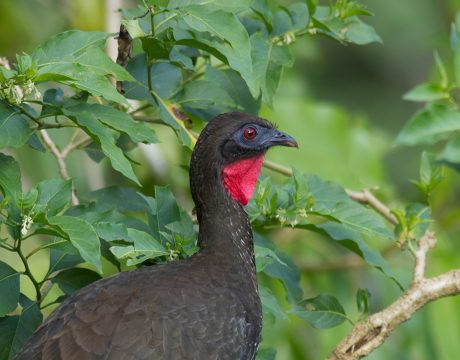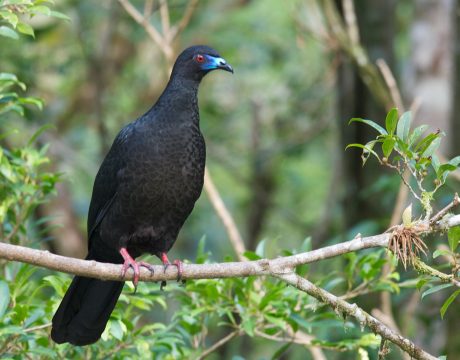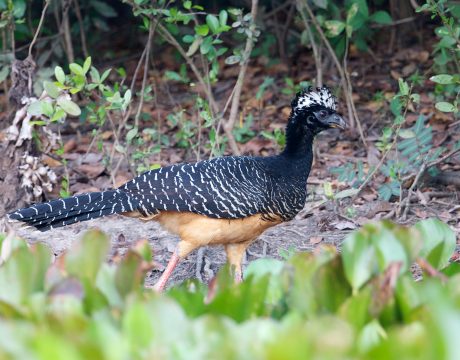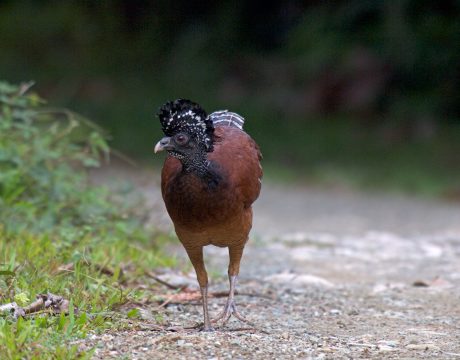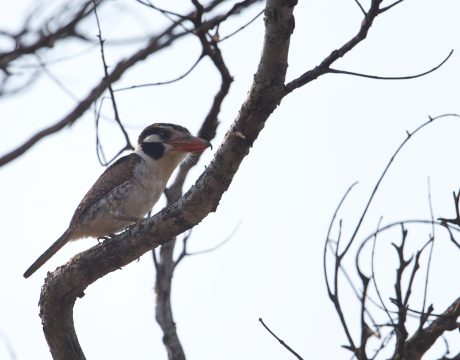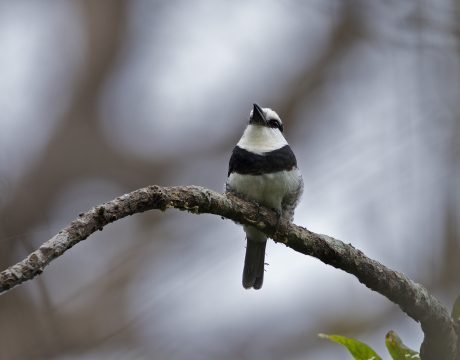Return of Bird of the Week: Chestnut-breasted Guan
This is a medium-sized guan, and in contrast to its tree-loving cousins, mostly forages on the ground. It’s the rarest Cracid – the family of Chachalacas, Guans and Currasows – that WC has photographed, and is likely globally threatened. Birds of the World (paywalled), one of the definitive sources of information on the 10,000 species of birds, says, “Comparatively little is known of the species’ natural history.” That’s an understatement. This species prefers the swampy forests and savannah of the Pantanal, the very large, seasonal swamp in eastern Bolivia and western Brazil, although smaller populations are found in central Brazil….
Return of Bird of the Week: Crested Guan
Last week you met your first Guan, the Black Guan. This week it’s a close cousin, the Crested Guan, another arboreal Cracid. Crested Guan, Costa Rica The Crested Guan is much larger than the Black, and is one of the largest of its genus, coming in at more than two kilograms. The bright red dewlap, red legs, black body, white-scalloped chest feathers and brownish tail make it another very distinctive species. And noisiest: not only does it have a loud, repetitive honking call, when it flies from tree to tree its landing sounds like a train wreck. For a species…
Return of Bird of the Week: Black Guan
While there are many other species of Curassow, WC hasn’t been able to photograph them, so we’ll switch to another clade of Cracidae, the Guans. And we’ll start with the Black Guan. It’s not a bird you’re likely to confuse with any other: black body, blue nares, bright red legs and bright red eye, it’s an arboreal cracid (WC likes that description and worked to find a way to get it into the blog post). It’s considerably smaller than the Curassows; just 69 centimeters long and weights a little over a kilogram. It’s less vocal than other guans, it’s unusual…
Return of Bird of the Week: Great Curassow
As promised, we’ll leave the obscure Puffbird family behind and shift the focus to the much larger, but even more obscure family Cracidae. These are the Curassows, Guans and Chachalacas of Neotropical forests. Prized by Native Americans as game birds, they have developed a healthy wariness of humankind. Those that weren’t wary became dinner, after all. There are 54 species of Cracidae; WC has photographed only a bare handful of them. To say they are secretive doesn’t begin to describe it. Birds in this family look somewhat like turkeys or pheasants, but those are distant relatives. We’ll start with the…
Return of Bird of the Week: Collared Puffbird
The Collared Puffbird is found in Amazonia, the Amazon River basin, including the lower eastern slopes of the Andes Mountains in Ecuador and Peru. WC was lucky enough to see and photograph – admittedly poorly – the species in Peru, where it is comparatively rare. In fact, eBird reports less than 300 sightings for Peru. The bright orange bill, cinnamon head and distinct black collar makes this a very easy bird to identify in the field. Its call, given generally before dawn, is a classic jungle sound, a loud: “awww awwAWW-chaw awwAWW-chaw awwAWW-chaw”, repeated up to six times. This species…
Return of Bird of the Week: White-eared Puffbird
Remember WC cautioned readers that some of the Puffbird photos were pretty sketchy. Here’s another. The White-eared Puffbird is found from eastern Peru and central Brazil south to Paraguay and northeastern Argentina. It prefers the middle levels of jungle forest and the gallery forests of the lowlands. Like other Puffbirds, it still-hunts from mid-level perches in trees and shrubs, and will take a wide range of prey, from insects to reptiles to crabs. White-eared Puffbirds have one of the most southerly distributions of any species of puffbird; there is some evidence that the southernmost populations of White-eared Puffbird are migratory, moving north in the austral…
Return of Bird of the Week: Gray-cheeked Nunlet
If there are puffbirds called “Monklets” you should have known there would be puffbirds called “Nunlets.” In fact, there is a whole genus of them, Nonnula, in which there are at least six species. The Gray-cheeked Nunlet is the only one of the six which WC has been able to photograph to date. It’s a pretty easy species to recognize: the reddish eye ring, cinnamon breast and brownish cap are distinctive. Ironically, the Gray-cheeked Nunlet is possibly the rarest of the six. This is a lowland species found in western Panama and eastern Columbia. Like all of the puffbirds, it’s an…
Return of Bird of the Week: White-necked Puffbird
WC has a few more photos of Puffbirds, but none of them are going to win any prizes for quality. Still, the birds are interesting enough that WC will share the mediocre documentation photos, with apologies for the sub-standard quality. Here’s a White-necked Puffbird, a species found from southern Mexico to Peru and much of Brazil. It’s one of the largest of the Puffbirds, and likely has the largest bill. It’s fairly uncommon across its entire range. Unlike its cousins you’ve met so far, this is generally a canopy bird, harder to find and photograph. This photograph is taken against the…






